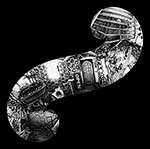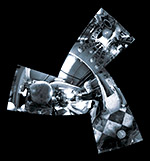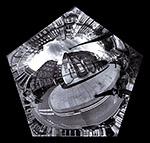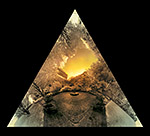|
|
Lloyd Burchill
Lloyd Burchill is the founder of Flaming Pear
Software, a Canadian maker of special-interest
and increasingly inexplicable Photoshop plug-ins,
which draw on science fiction, obscure
photochemical techniques, panoramas, cartography,
medical imaging, image fusion, and discredited
theories of colour. An erstwhile dot-com victim,
he now splices photography, coding, travel, and
business into a formless m&�acute;lange.
Technical Details
The spherical images come from various sources: the reflection in a
silver Christmas-tree ornament or a garden gazing ball, a world map,
or, for maximum quality, the Robot Camera.
- I built an automatic panoramic gantry using Lego Mindstorms and
Apple's Image Capture API, and wrote software to operate it.
A state machine called TakePictures runs on a PowerBook and talks via
AppleScript with Barney Hilken's Robot Controller, which talks via
USB and an infrared link to another custom state machine -- written
with MacNQC -- running on the Lego Mindstorms RCX brick. The brick
powers the azimuthal and declinatory motors. Rotation sensors report
whether the camera it pointing where it's supposed to.
- The tripod+camera+software takes about 50 pictures in all
directions. It starts with the camera at the zenith and scans down
toward the nadir, while a serpentine raster keeps twist from
accumulating in the cables. TakePictures talks via Apple's Image
Capture API to a Canon PowerShot A620, which kind of supports a
poorly documented quasi-standard for obeying picture-taking commands
over USB.
If people are walking through the scene or clouds are scudding across
the sky, I may do two or three complete passes to ensure adequate
coverage. Infrared lens filtering is ideal for mackerel skies.
- Then I winnow the shots into a best set and batch-remove radial
lens distortion with Kekus LensFix and Photoshop. Next I merge these
into a single equirectangular panorama in Stitcher 5.5 using its
SmartBlend option, and retouch problems in Photoshop.
- Then I bring the resulting equirectangular into Flexify and hunt
for a projection and viewing parameters that suit the subject. Mainly
it's a tradeoff between clarity and dizzyingness, but many panos are
also beset by serious compositional problems. Often the issue is a
simple sparsity of interesting features. Dull parts of the scene can
be concealed and the cool parts amplified with the right choice of
view.
- Lastly I sweeten the final result with custom tools like Kyoto
Color and Mr. Contrast.
|





|
|
|